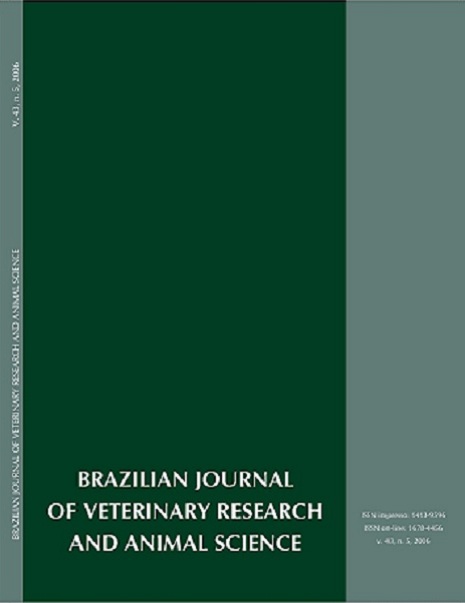Use of probiotics in the diets of pigs: diarrhea incidence, animal performance and feed digestibility
DOI:
https://doi.org/10.11606/issn.1678-4456.bjvras.2006.26576Keywords:
Bacillus, Diarrhea, Digestibility of nutrients, Lactobacillus, PigAbstract
Two trials were conducted aiming to of evaluate the effect of probiotic supplementation in pig´s diet: Trial 1: diarrhea incidence and performance; Trial 2: feed intake and digestibility. In the Trial 1, forty weaning barrow piglets were distributed in four treatments: T0-basal diet; T100-basal diet +100ppm of probiotic; T200-basal diet +200ppm e T300-basal diet +300ppm. The trial 2 was a digestibility trial, where eight barrow pigs were used, distributed in two treatments: T1-basal diet and T2-basal diet + 200 ppm of same probiotic used in the Experiment 1. In the Period 1 the animals of T0 and T100 groups showed higher diarrhea incidence (P<0.05) than the T200 and T300 groups. The performance of animals of T100 group were lower than other treatment groups (P<0.05). In the Period 2 the T200 and T300 animals, showed better FG ratio than the animals of T0 (P<0.05). In the total period it was not observed significative difference concerning performance, except for DFI. In the trial 2, the animals of treatment T2, showed an increase of feed intake when compared with animals of T1. Digestibility coefficients showed no significative differences among treatments. It was concluded that the addition of 200 and 300 ppm of probiotic in the Period 1 reduces incidences of diarrhea. But, in the total period of trial 1, the performance was similar among treatments. In the trial 2 it was observed better adaptation of animals receiving probiotics which was represented by higher feed intake.Downloads
Download data is not yet available.
Downloads
Published
2006-10-01
Issue
Section
UNDEFINIED
License
The journal content is authorized under the Creative Commons BY-NC-SA license (summary of the license: https://
How to Cite
1.
Huaynate RAR, Thomaz MC, Kronka RN, Fraga AL, Scandolera AJ, Budiño FEL. Use of probiotics in the diets of pigs: diarrhea incidence, animal performance and feed digestibility. Braz. J. Vet. Res. Anim. Sci. [Internet]. 2006 Oct. 1 [cited 2024 Apr. 18];43(5):664-73. Available from: https://revistas.usp.br/bjvras/article/view/26576





